The Six Excesses and Their Syndromes
The Six Excesses: Feng (Wind), Han (Cold), Shu (Summer Heat), Shi (Dampness), Zao (Dryness), Huo (Fire) are pathogenic factors that invade the body. The characteristics of the Six Excesses include: firstly, they are related to season and living environment; for example, in summer, there are many cases of heat-related illnesses; those who live in damp places are prone to dampness; secondly, the Six Excesses are classified as external pathogens, which often invade the body through the mouth, nose, and skin, commonly presenting with exterior symptoms at the onset; thirdly, the Six Excesses often combine to cause disease, and during the progression of the illness, they frequently interact or transform into one another.
(1) Wind Syndrome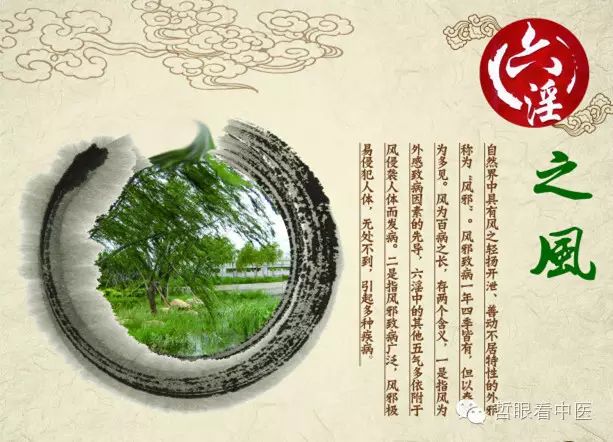 Wind syndrome refers to a category of diseases caused by the invasion of wind pathogens. Wind is known as the leader of all diseases; its nature is light, dispersive, and variable, thus it is characterized by rapid onset, quick resolution, and erratic symptoms.
Wind syndrome refers to a category of diseases caused by the invasion of wind pathogens. Wind is known as the leader of all diseases; its nature is light, dispersive, and variable, thus it is characterized by rapid onset, quick resolution, and erratic symptoms. 【Clinical Manifestations】 Fever, aversion to wind, headache, sweating, cough, nasal congestion, and runny nose. The tongue has a thin white coating, and the pulse is floating and slow, or there may be numbness in the limbs and face, facial drooping, stiff neck, limb spasms, or skin itching. 【Syndrome Analysis】 Wind pathogens invade the exterior, damaging the defensive qi, causing the pores to open and close abnormally, leading to symptoms of fever, aversion to wind, headache, and sweating. Wind invades the lungs, disrupting the liver’s ability to disperse qi, resulting in cough, nasal congestion, and runny nose. The floating and slow pulse, along with the thin white coating, indicates the invasion of wind into the defensive layer. When wind invades the meridians, it obstructs the flow of qi, leading to numbness, facial drooping, stiffness, and spasms. When wind affects the skin, it causes itching.(2) Cold Syndrome
【Clinical Manifestations】 Fever, aversion to wind, headache, sweating, cough, nasal congestion, and runny nose. The tongue has a thin white coating, and the pulse is floating and slow, or there may be numbness in the limbs and face, facial drooping, stiff neck, limb spasms, or skin itching. 【Syndrome Analysis】 Wind pathogens invade the exterior, damaging the defensive qi, causing the pores to open and close abnormally, leading to symptoms of fever, aversion to wind, headache, and sweating. Wind invades the lungs, disrupting the liver’s ability to disperse qi, resulting in cough, nasal congestion, and runny nose. The floating and slow pulse, along with the thin white coating, indicates the invasion of wind into the defensive layer. When wind invades the meridians, it obstructs the flow of qi, leading to numbness, facial drooping, stiffness, and spasms. When wind affects the skin, it causes itching.(2) Cold Syndrome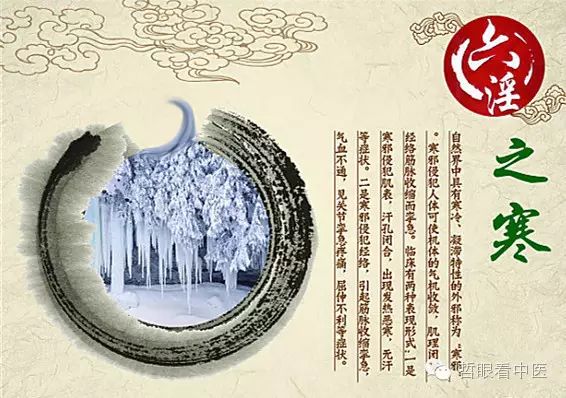 Cold syndrome refers to a category of diseases caused by the invasion of cold pathogens. Cold is a yin pathogen, characterized by its cold and constricting nature, which easily injures yang qi and obstructs the flow of qi and blood.
Cold syndrome refers to a category of diseases caused by the invasion of cold pathogens. Cold is a yin pathogen, characterized by its cold and constricting nature, which easily injures yang qi and obstructs the flow of qi and blood. 【Clinical Manifestations】 Aversion to cold, fever, no sweating, headache, body aches, cough, nasal congestion, thin white coating on the tongue, and a tight floating pulse. There may also be stiffness in the limbs, cold extremities, a weak pulse, abdominal pain, borborygmus, diarrhea, or vomiting. 【Syndrome Analysis】 Cold pathogens bind the exterior, causing a cold and constricting effect, leading to obstruction of the defensive yang qi, resulting in symptoms of fever, aversion to cold, and no sweating. Cold pathogens stagnate in the meridians, causing headache and body aches. The lungs are associated with the skin; when the skin is affected, the lung qi is obstructed, leading to cough and nasal congestion. The tight floating pulse and thin white coating indicate the presence of cold in the exterior. If cold pathogens stagnate in the meridians and damage yang qi, it leads to stiffness in the limbs; if cold condenses and yang qi fails to reach the extremities, it results in cold extremities; if cold condenses internally, damaging the spleen and stomach yang, it leads to abdominal pain, borborygmus, vomiting, and diarrhea.(3) Summer Heat Syndrome
【Clinical Manifestations】 Aversion to cold, fever, no sweating, headache, body aches, cough, nasal congestion, thin white coating on the tongue, and a tight floating pulse. There may also be stiffness in the limbs, cold extremities, a weak pulse, abdominal pain, borborygmus, diarrhea, or vomiting. 【Syndrome Analysis】 Cold pathogens bind the exterior, causing a cold and constricting effect, leading to obstruction of the defensive yang qi, resulting in symptoms of fever, aversion to cold, and no sweating. Cold pathogens stagnate in the meridians, causing headache and body aches. The lungs are associated with the skin; when the skin is affected, the lung qi is obstructed, leading to cough and nasal congestion. The tight floating pulse and thin white coating indicate the presence of cold in the exterior. If cold pathogens stagnate in the meridians and damage yang qi, it leads to stiffness in the limbs; if cold condenses and yang qi fails to reach the extremities, it results in cold extremities; if cold condenses internally, damaging the spleen and stomach yang, it leads to abdominal pain, borborygmus, vomiting, and diarrhea.(3) Summer Heat Syndrome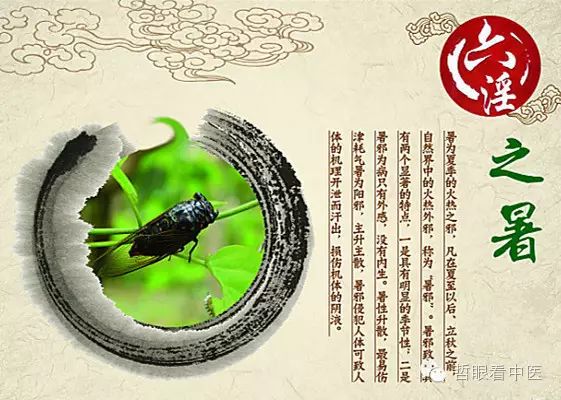 Summer heat syndrome refers to a category of diseases caused by the invasion of summer heat pathogens. Summer heat is characterized by its hot and dispersive nature, often leading to heat symptoms and easily damaging qi and fluids, and it often combines with dampness to form complex illnesses.
Summer heat syndrome refers to a category of diseases caused by the invasion of summer heat pathogens. Summer heat is characterized by its hot and dispersive nature, often leading to heat symptoms and easily damaging qi and fluids, and it often combines with dampness to form complex illnesses. 【Clinical Manifestations】 Heat injury, fever, sweating, thirst, fatigue, yellow urine, red tongue, white or yellow coating, and a weak rapid pulse. Heat stroke may present with sudden fainting, continuous sweating, thirst, shortness of breath, and even coma or convulsions, with a dry tongue and rapid pulse. 【Syndrome Analysis】 Heat injury occurs due to excessive sweating from summer heat and dampness, leading to depletion of fluids and qi. The hot nature of summer heat causes thirst, excessive sweating, and yellow urine; excessive sweating leads to fatigue and a weak rapid pulse; when summer heat combines with dampness, it can lead to a white or yellow coating on the tongue. In cases of heat stroke, prolonged exposure to intense summer heat can disturb the mind, leading to sudden fainting. The heat damages fluids and qi, causing symptoms of fever, thirst, sweating, and shortness of breath; if the heat obstructs the mind, it can lead to confusion; if the heat damages fluids and causes internal wind, it can lead to convulsions; if the heat is severe, it can lead to dryness of the tongue and rapid pulse.(4) Dampness Syndrome
【Clinical Manifestations】 Heat injury, fever, sweating, thirst, fatigue, yellow urine, red tongue, white or yellow coating, and a weak rapid pulse. Heat stroke may present with sudden fainting, continuous sweating, thirst, shortness of breath, and even coma or convulsions, with a dry tongue and rapid pulse. 【Syndrome Analysis】 Heat injury occurs due to excessive sweating from summer heat and dampness, leading to depletion of fluids and qi. The hot nature of summer heat causes thirst, excessive sweating, and yellow urine; excessive sweating leads to fatigue and a weak rapid pulse; when summer heat combines with dampness, it can lead to a white or yellow coating on the tongue. In cases of heat stroke, prolonged exposure to intense summer heat can disturb the mind, leading to sudden fainting. The heat damages fluids and qi, causing symptoms of fever, thirst, sweating, and shortness of breath; if the heat obstructs the mind, it can lead to confusion; if the heat damages fluids and causes internal wind, it can lead to convulsions; if the heat is severe, it can lead to dryness of the tongue and rapid pulse.(4) Dampness Syndrome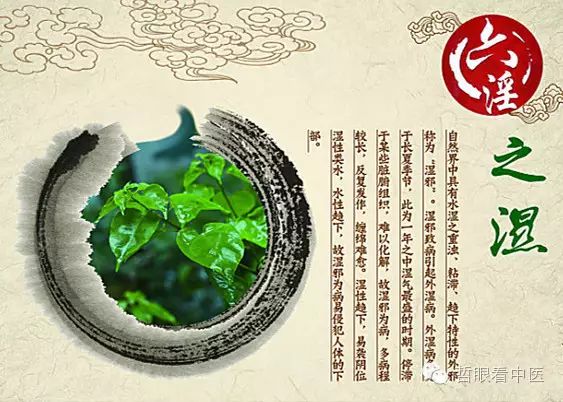 Dampness syndrome refers to a category of diseases caused by the invasion of damp pathogens. Dampness is characterized by its heavy and sticky nature, which easily obstructs the flow of qi and damages yang qi, leading to prolonged and lingering symptoms.
Dampness syndrome refers to a category of diseases caused by the invasion of damp pathogens. Dampness is characterized by its heavy and sticky nature, which easily obstructs the flow of qi and damages yang qi, leading to prolonged and lingering symptoms. 【Clinical Manifestations】 Injury from dampness leads to headache and heaviness, chest tightness, no thirst, body heaviness and pain, fever, fatigue, clear and prolonged urination, white slippery tongue coating, and a weak or slow pulse. When dampness is severe, it can cause a feeling of heaviness in the head, discomfort throughout the body, weakness in the limbs, and a weak pulse. Dampness can also invade the joints, leading to joint pain and difficulty in movement. 【Syndrome Analysis】 Injury from dampness occurs when damp pathogens invade during rainy seasons, often referred to as exterior dampness syndrome. The heavy and sticky nature of dampness obstructs the flow of qi, leading to symptoms such as headache, chest tightness, fatigue, and body heaviness. Dampness competes with the defensive qi, leading to fever and sweating without resolution. As dampness is a yin pathogen, it does not damage fluids, hence there is no thirst. Clear and prolonged urination, white slippery tongue coating, and a weak or slow pulse indicate the presence of dampness. When dampness invades the head, it can cause a feeling of heaviness. When dampness pervades the body, it obstructs the flow of yang qi, leading to discomfort throughout the body. When dampness invades the joints, it can cause pain and difficulty in movement, clinically referred to as “bi syndrome”.(5) Dryness Syndrome
【Clinical Manifestations】 Injury from dampness leads to headache and heaviness, chest tightness, no thirst, body heaviness and pain, fever, fatigue, clear and prolonged urination, white slippery tongue coating, and a weak or slow pulse. When dampness is severe, it can cause a feeling of heaviness in the head, discomfort throughout the body, weakness in the limbs, and a weak pulse. Dampness can also invade the joints, leading to joint pain and difficulty in movement. 【Syndrome Analysis】 Injury from dampness occurs when damp pathogens invade during rainy seasons, often referred to as exterior dampness syndrome. The heavy and sticky nature of dampness obstructs the flow of qi, leading to symptoms such as headache, chest tightness, fatigue, and body heaviness. Dampness competes with the defensive qi, leading to fever and sweating without resolution. As dampness is a yin pathogen, it does not damage fluids, hence there is no thirst. Clear and prolonged urination, white slippery tongue coating, and a weak or slow pulse indicate the presence of dampness. When dampness invades the head, it can cause a feeling of heaviness. When dampness pervades the body, it obstructs the flow of yang qi, leading to discomfort throughout the body. When dampness invades the joints, it can cause pain and difficulty in movement, clinically referred to as “bi syndrome”.(5) Dryness Syndrome Dryness syndrome refers to a category of diseases caused by the invasion of dryness pathogens. Dryness is characterized by its dry nature, which easily damages fluids, and can be classified into cool dryness and warm dryness.
Dryness syndrome refers to a category of diseases caused by the invasion of dryness pathogens. Dryness is characterized by its dry nature, which easily damages fluids, and can be classified into cool dryness and warm dryness. 【Clinical Manifestations】 Cool dryness presents with severe aversion to cold, mild fever, headache, no sweating, cough, throat itchiness, nasal congestion, dry white tongue, and a floating pulse. Warm dryness presents with body heat, mild aversion to wind and cold, headache, little sweating, thirst, irritability, dry cough with little phlegm, and even blood-streaked phlegm, with dry skin and nasal passages, dry tongue with yellow coating, and a rapid floating pulse. 【Syndrome Analysis】 Cool dryness often occurs in late autumn when the weather turns cool, and dryness combines with cold to cause illness. Dryness and cold invade the lung’s defensive layer, leading to symptoms such as severe aversion to cold, mild fever, headache, and no sweating, along with cough, nasal congestion, throat itchiness, dry tongue, and floating pulse. Warm dryness occurs in early autumn when the weather is still hot, and dryness and heat combine to damage fluids, leading to symptoms such as fever, mild aversion to wind and cold, headache, little sweating, dry cough, and irritability. The dry tongue with yellow coating and rapid floating pulse indicate the presence of dryness and heat.(6) Fire Syndrome
【Clinical Manifestations】 Cool dryness presents with severe aversion to cold, mild fever, headache, no sweating, cough, throat itchiness, nasal congestion, dry white tongue, and a floating pulse. Warm dryness presents with body heat, mild aversion to wind and cold, headache, little sweating, thirst, irritability, dry cough with little phlegm, and even blood-streaked phlegm, with dry skin and nasal passages, dry tongue with yellow coating, and a rapid floating pulse. 【Syndrome Analysis】 Cool dryness often occurs in late autumn when the weather turns cool, and dryness combines with cold to cause illness. Dryness and cold invade the lung’s defensive layer, leading to symptoms such as severe aversion to cold, mild fever, headache, and no sweating, along with cough, nasal congestion, throat itchiness, dry tongue, and floating pulse. Warm dryness occurs in early autumn when the weather is still hot, and dryness and heat combine to damage fluids, leading to symptoms such as fever, mild aversion to wind and cold, headache, little sweating, dry cough, and irritability. The dry tongue with yellow coating and rapid floating pulse indicate the presence of dryness and heat.(6) Fire Syndrome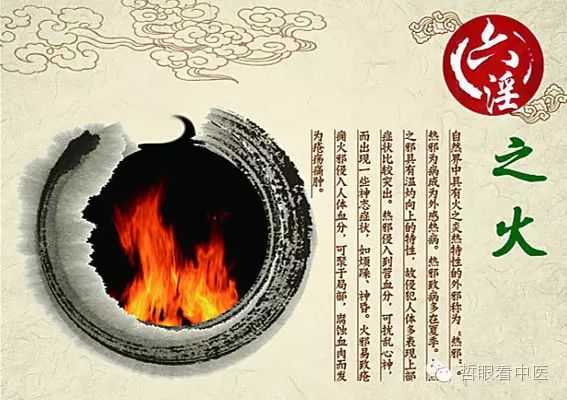 Fire syndrome refers to a broad category of diseases caused by fire heat pathogens. Fire heat is characterized by its burning and urgent nature, often presenting with significant heat symptoms throughout the body or locally, easily damaging yin fluids, leading to dryness and internal wind, and can also cause blood to move erratically, resulting in bleeding.
Fire syndrome refers to a broad category of diseases caused by fire heat pathogens. Fire heat is characterized by its burning and urgent nature, often presenting with significant heat symptoms throughout the body or locally, easily damaging yin fluids, leading to dryness and internal wind, and can also cause blood to move erratically, resulting in bleeding. 【Clinical Manifestations】 High fever, thirst, red face and eyes, irritability, sweating, or agitation and delirium, nosebleeds, vomiting blood, rashes, or manic behavior, or the presence of boils and pus, with a red tongue and a rapid or thin pulse. 【Syndrome Analysis】 Fire heat pathogens invade the qi level, leading to symptoms of high fever, thirst, red face and eyes, and a rapid pulse. If the pathogenic qi does not resolve at the qi level and enters the blood level, it can lead to bleeding, rashes, and skin eruptions. If fire heat is excessive, it can disturb the heart and liver, leading to agitation and delirium. If fire toxins accumulate between the flesh, they can lead to pus and necrosis. A red tongue and rapid pulse indicate the presence of fire heat penetrating deeply into the blood level.
【Clinical Manifestations】 High fever, thirst, red face and eyes, irritability, sweating, or agitation and delirium, nosebleeds, vomiting blood, rashes, or manic behavior, or the presence of boils and pus, with a red tongue and a rapid or thin pulse. 【Syndrome Analysis】 Fire heat pathogens invade the qi level, leading to symptoms of high fever, thirst, red face and eyes, and a rapid pulse. If the pathogenic qi does not resolve at the qi level and enters the blood level, it can lead to bleeding, rashes, and skin eruptions. If fire heat is excessive, it can disturb the heart and liver, leading to agitation and delirium. If fire toxins accumulate between the flesh, they can lead to pus and necrosis. A red tongue and rapid pulse indicate the presence of fire heat penetrating deeply into the blood level.

